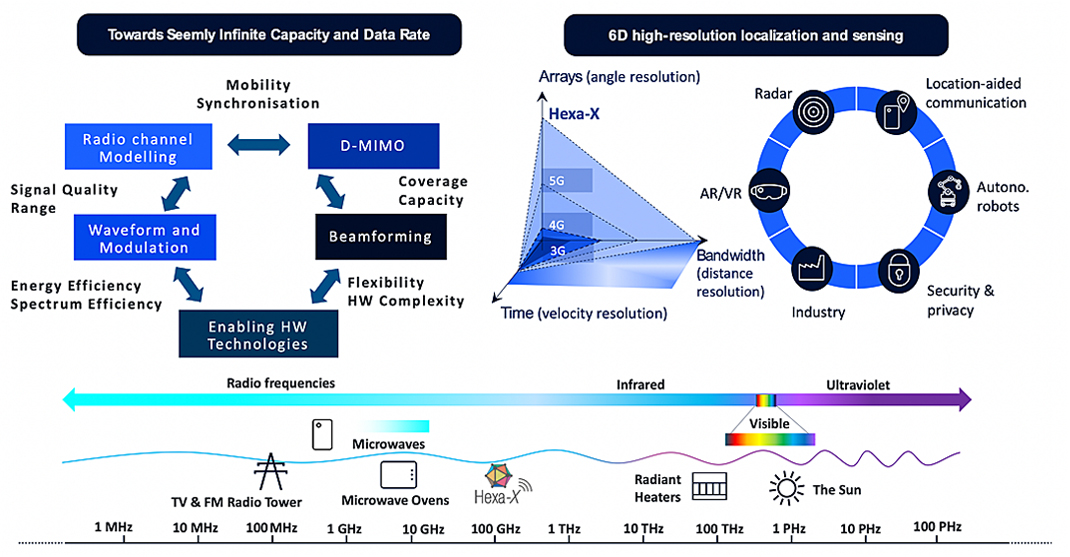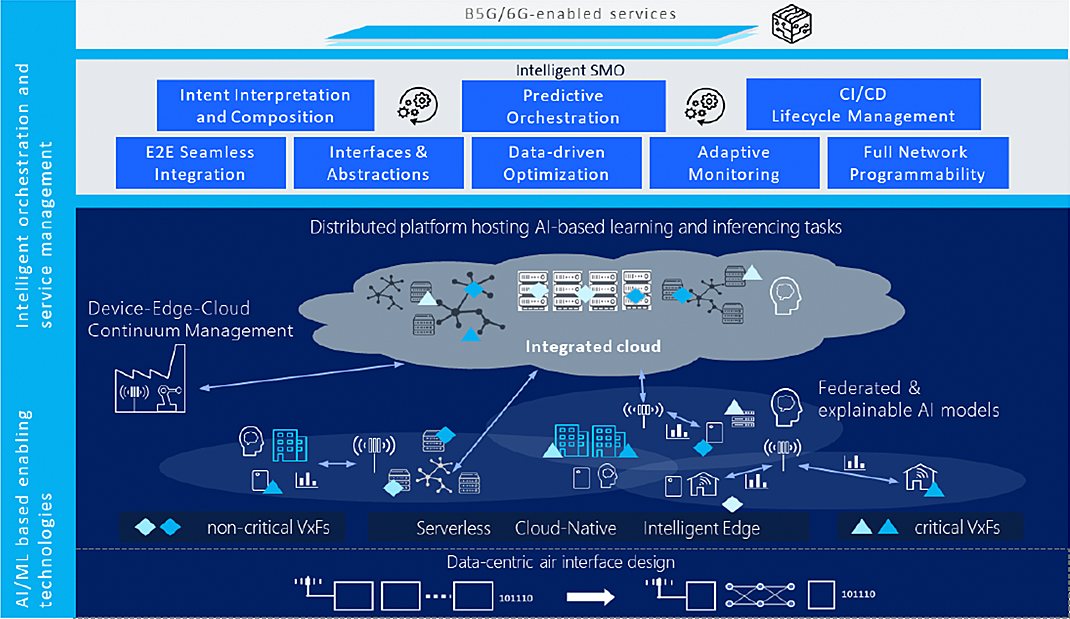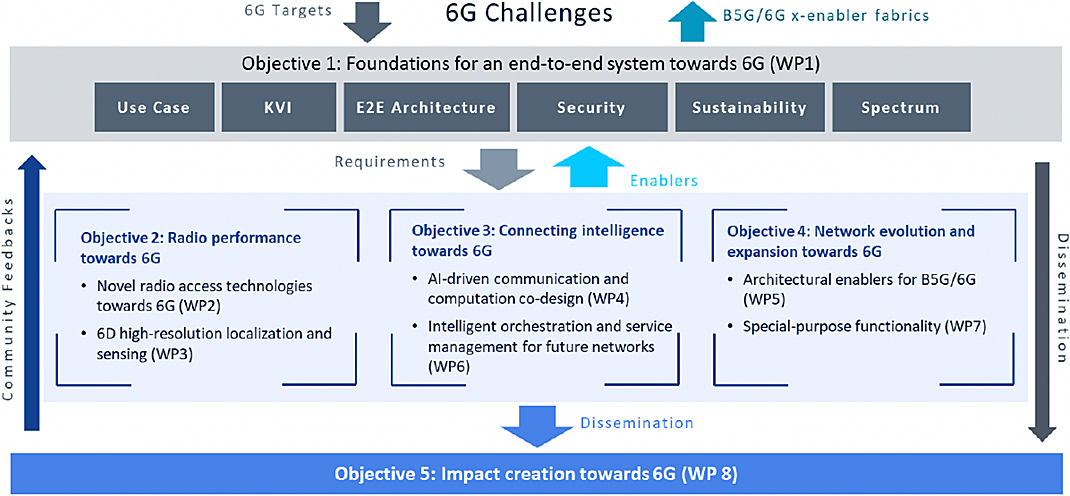Project overview structure
Objective 1:
Foundation for an end-to-end system architecture
WP1
Work Package 1 develops the 6G x-enabler fabric and the KVIs for a vision of connecting intelligence, sustainability, trustworthiness, inclusion, and extreme experience. It consists of seven tasks which focus on the following activities:
Task 1.1 “Common Vision” will analyze current trends in society and technology, create and tune the underlying vision to guide the project and identify relevant principles impacting business models.
Task 1.2 “Services, use cases” will define Hexa-X use cases based on and enhanced from existing use cases of the state of the art, synchronize with technical work packages as use cases will be the guidelines for the technical work packages and execute joint work with Task 1.3 on KVIs / KPIs to identify key performance / values indicators (and requirements) related to use cases.
Task 1.3 “KVI & performance” will derive meaningful key performance indicators from the use cases and scenarios from Task 1.2 and derive measures for “soft” goals such as sustainability, inclusion, and flexibility (KVIs).
Task 1.4 “E2E architecture” will define an initial E2E architecture vision based on architectural requirements provided by vision, services and use cases, align and integrate E2E security architecture concepts (Task 1.7 related) and relevant architecture enablers (esp. WP5), work on cross-domain management orchestration automation (WP6 related), flexible functionality deployment (e.g., ML/AI components) and flexible network architectures (device to device / infrastructure).
Task 1.5 “Spectrum” will deliver an overview and assessment of the regulatory environment in terms of spectrum allocations in Europe and worldwide in the frequency range/ranges under consideration and monitoring of possible regulation evolution worldwide (e.g., trials and experimental licensing) and develop innovative concepts and enablers for enhanced flexible spectrum usage and management.
Task 1.6 “Sustainability” will identify sustainability targets, relying on the 17 sustainable development goals defined by the United Nations as a basis, as well as other resources (e.g., GSMA climate Action Roadmap (link)), synchronize the technical work within the project providing solutions to reach these sustainability targets while monitoring progress of EMF regulation and studies on their potential health impact and work on the global impact of the project on sustainability: production of a synthesis of the results and gains with respect to these sustainability targets.
Task 1.7 “Security” will analyze residual cyber security risks of today’s networks and those induced by the adoption of new architectures and technologies, such as pervasive softwarization or AI intensive application, analyze the evolution of the “cyber-attack ecosystem”, including the possible adoption by miscreants of the same technologies supporting network evolution and provide security-related support to other technical WPs and integrate all security considerations relevant to technologies investigated in the project.
Objective 2:
Radio performance towards 6G
Deliver extreme performance by developing and assessing key radio technology components for the next generation, through higher bands and localisation/sensing.

Objective 2 will be addressed by two work packages: WP2 and WP3.
WP2
Work Package 2 will develop innovative key radio enabling technologies for achieving ultra-high data rate transmission and capacity taking hardware and channel aspects into account. Energy efficiency will be one of the major concerns for design. The outputs are expected to generate impact on R&I process towards 6G in EU and globally. It consists of six tasks which focus on the following activities:
Task 2.1 “Radio enablers and technology roadmap” – Identify and evaluate key technology enablers based on the envisioned use cases and requirements for evolution from Gbps to Tbps communications in 6G; predict relevant future development and synthesise research output into a long-term technology roadmap.
Task 2.2 “Radio and antenna implementation aspects, hardware component models and architecture” – Evaluate current status and envision/predict future trends on hardware enabling technologies including antennas, RF and DSP for systems operating above 100 GHz and supporting data rates above 100 Gbps as well as provide hardware impairment models for air interface research.
Task 2.3 “Hardware-aware waveform and modulation design” – Evaluate the suitability of legacy waveforms and develop waveforms more appropriate, e.g., from energy efficiency point of view, for radio communications above 100 GHz taking hardware characteristics into account.
Task 2.4 “Hardware-aware beamforming design” – Study beamforming design for enabling 6G use cases, accounting for hardware limitations, complexity and energy efficiency, as well as the associated challenge stemming from antenna array design above 100 GHz.
Task 2.5 “Distributed large MIMO systems for beyond 5G/6G” – Investigate enabling techniques for scalable distributed large antenna systems with converged access-backhaul-fronthaul in beyond 5G/6G systems towards seemingly infinite network capacity for both below and above 100 GHz.
Task 2.6 “Channel measurement and modelling for beyond 100 GHz” – Conduct RF measurements, collect experimental evidence of RF characteristics of wave propagation and material-wave interaction and construct a mathematical model of the measured data sets for air interface research above 100 GHz.
WP3
Work Package 3 will connect the physical and digital world through advanced localization and sensing approaches. It will realize extremely accurate and fast situational awareness in 6D (3D position and 3D orientation), map passive objects in the environment through mono-, bi-, and multi-static setups, thereby enabling Hexa-X use cases. The WP comprises 3 tasks:
Task 3.1: “Gap analysis for high-resolution localization and sensing” – Identify and evaluate key technology enablers based on the envisioned use cases and requirements for the evolution towards centimeter-level accuracy in 6G.
Task 3.2: “Methods, signals and protocols for localization and mapping” – Following the activities, in WP2, develop novel methods, signals, and designs for localization and sensing, as well as interference management and coverage optimization. This task also includes an over-the-air demonstration in collaboration with WP2.
Task 3.3: “Location and mapping-enhanced service operation” – Leveraging highly accurate location and map information to improve communication in terms of latency, overhead, and energy. In parallel, explore enabling and enriching applications in the context of augmented and mixed reality, security, and human-machine co-working.
Objective 3:
Connecting intelligence towards 6G
Deliver methodology, algorithms, and architectural requirements for an AI-native network, through
AI-driven air interface and AI governance.

Objective 3 will be addressed by two work packages: WP4 and WP6.
WP4
WP4 will: (i) enhance the performance of the B5G/6G air interface via introducing low complexity AI-based solutions, as well as (ii) propose design concepts for a B5G/6G learning platform, able to optimally support and address distributed edge workloads and learning/ inferencing mechanisms, with respect to latency, reliability, scalability, energy efficiency, security, manageability, explainability and knowledge sharing requirements.
Task 4.1: “Gap analysis for AI-driven communication and computation co-design” will identify challenges of introducing AI/ML to networking for 6G systems.
Task 4.2: “AI-driven air interface design” will explore novel data-driven transceiver design approaches allowing for quick reconfiguration and adaptation of the transceiver to specific operation environments as well as study performance gain in terms of complexity reduction and evaluate model accuracy compared to traditional methods.
Task 4.3: “Methods and algorithms for sustainable and secure distributed AI” will explore how data and their analytics can be treated as monetizable utilities, exchangeable among network elements. It will also produce implementation requirements calling for new architectural components (“AI functions”) to leverage the AI-based functionality of the network, as well as design distributed AI/ML techniques for the joint allocation and management of network’s communication and computation resources, to fulfil strict 6G performance requirements.
WP6
WP6 will address aspects such as predictive orchestration and service management, slicing without overprovisioning, slice elasticity according to traffic conditions, and real-time, zero-touch automation. The work will cover both planning and run-time phases of the orchestration process and how to apply AI mechanisms to multiple actions for having an intelligent end-to-end orchestration.
Task 6.1: “Gap analysis for service management and orchestration” will perform a thorough analysis of the state-of-the-art for service management and orchestration and identify prospective technological features and solutions.
Task 6.2: “Automation, network and service programmability” will explore evolving network capabilities and develop mechanisms network and service management, including e.g. high-level intent-based application requirements and service description models and profiling and develop intelligence to optimally match network capabilities and external non-network factors to expected service layer quality, considering network performance and societal aspects.
Task 6.3: “E2E seamless integration management” will develop methods for management and orchestration of the Device-Edge-Cloud continuum and addressing the pervasiveness of non-public networks in terms of infrastructure sharing, capability exposure, discovery, as well as cross-domain management automation.
Task 6.4: “Data-driven management and orchestration” will address the handling of data from all network segments to achieve zero-perceived latency, e.g. by proactive network slice management and dynamic self-optimisation of network slices as well as cross-layer predictions mixing application and infrastructure-based cognition to trigger self-adaptation and self-optimization decisions.
Objective 4:
Network evolution and expansion towards 6G
Deliver enablers for an intelligent network of networks, through network disaggregation and
dynamic dependability.

Objective 4 will be addressed by two work packages: WP5 and WP7.
WP5
WP5 will develop the architectural components that support a new flexible network design, full AI integration and network programmability and, at the same time, streamline and redesign the architecture for a network of networks. WP5 is divided into the following tasks:
Task 5.1 “Architecture transformation” will perform a gap analysis will be performed to identify limitations of existing architectures.
Task 5.2: “Intelligent networks” will design and evaluate dynamic function placement. hardware acceleration, integrated and distributed AI with supporting protocols, network and device programmability and processing offloading.
Task 5.3: “Flexible networks” will develop a new architecture for flexible network topologies, building a ‘network of networks’ including legacy networks.
Task 5.4: “Efficient networks” will streamline and redesign the network as well as reduce cost (TCO) and complexity utilizing a cloud-native service-based RAN and CN with fewer parameters to configure and fewer external interfaces
WP7
WP7 will boost B5G/6G network performance in extreme environments where digital, physical, and human worlds converge with special-purpose functionality (e.g., modular flexible production, zero-energy communications for sensors, and on-demand connectivity in remote and rural areas). It consists of four tasks, which focus on the following topics:
Task 7.1 “Gap analysis for special-purpose functionality” will sharpen requirements and formulate first solutions for extreme environments, shaping the technical work plans for the other tasks in WP7 and serving as input to the end-to-end view on use cases and requirements in WP1.
Task 7.2 “Ultra-flexible heterogeneous resource allocation” will address sustainable coverage through ultra-flexible resource allocation procedures in challenging environments (demanding, e.g., reliability, energy-efficiency, security, EMF) and management and methods to repurpose and share existing infrastructure.
Task 7.3 “Dependability beyond URLLC” will develop mechanisms and enablers for high dependability in vertical scenarios, enabling efficient resource support of complex and dynamically changing availability requirements from an end-to-end perspective. This includes the definition of end-to-end measures for dependability and economically viable cross-layer approaches for communication-control-codesign.
Task 7.4 “HMIs and the Digital Twin” will support the convergence of the biological, digital and physical worlds with human interaction through novel HMI concepts and an execution environment for a privacy-preserving high-availability Digital Twin.

 Project Lead (Coordinator)
Project Lead (Coordinator)